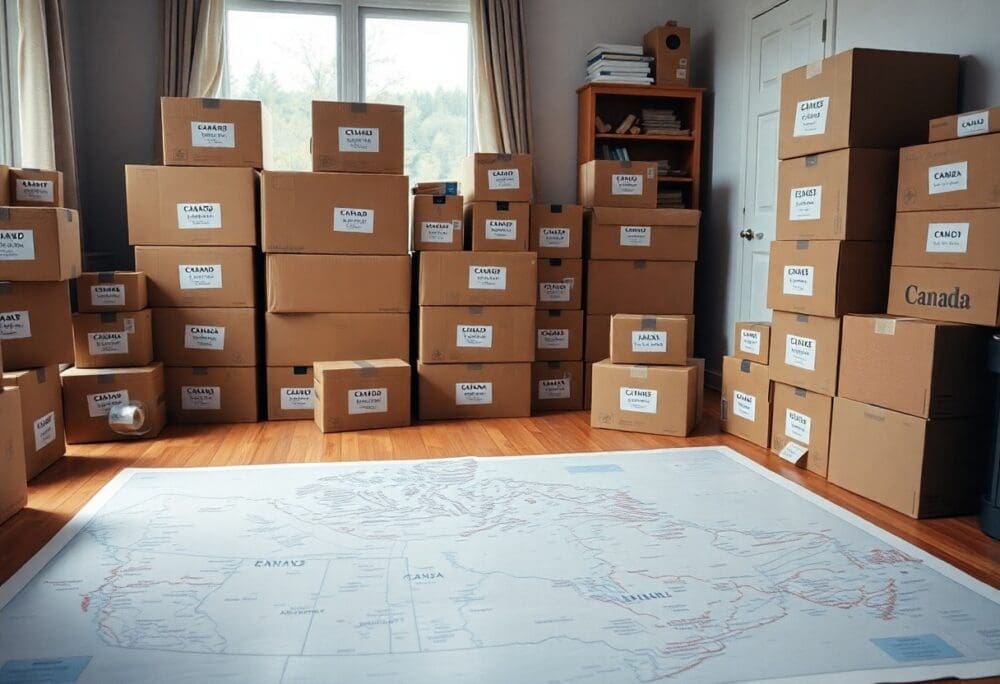Most families underestimate how early they should start planning a move across Canada. Timely preparation not only reduces stress but also ensures that your transition is smooth and efficient. Begin your planning at least three to six months before your intended move date; this allows you to manage logistics, find suitable housing, and settle your children into new schools. Proactive organization mitigates potential pitfalls, making the entire experience more positive for everyone involved.
Key Takeaways:
- Begin planning at least 3-6 months in advance to secure accommodations and services.
- Consider the timing of the move, aligning with school schedules and seasonal conditions.
- Involve the whole family in the planning process to ensure a smoother transition.
Understanding the Moving Timeline
The moving timeline is imperative to ensure a smooth transition when relocating your family across Canada. By establishing a clear schedule, you can account for all necessary arrangements, from finding a new home to packing and transporting your belongings. Being aware of the various phases in your timeline allows you to prioritize tasks effectively and manage stress.
Factors Influencing the Timeline
Several elements can significantly influence your moving timeline. These include the distance of the move, the time of year, your family’s specific needs, and the availability of professional moving services. Considering these factors will help you outline a realistic plan.
- Distance – Longer moves require more time.
- Season – Summer is peak moving season, impacting availability.
- Family needs – Special requirements may extend timelines.
- Moving services – Book early to secure your choice.
Assume that understanding these factors allows for a more tailored moving plan.
Ideal Timeframes for Different Moving Scenarios
Your timeframe will vary based on several unique scenarios. If you’re relocating within the same city, a planning period of 1-2 months may suffice. In contrast, an interprovincial move should ideally have a 3-6 month preparation window. If you aredownsizing or upsizing your home, involving real estate agents may necessitate additional time to align selling and buying processes.
Preparing for the Move
Planning for your move involves several steps to ensure a smooth transition. Start by researching the best time of year to plan a long-distance move in Canada, allowing you to select an optimal moving date that aligns with your family’s schedule and costs. Create a checklist outlining major tasks and deadlines, which can significantly help keep you organized as the moving date approaches.
Creating a Moving Plan
A comprehensive moving plan is important for your family’s relocation. Begin by mapping out all necessary tasks, such as notifying schools and changing addresses for services. Prioritize your list and assign deadlines to ensure you remain on track. Involving family members in this process can also make the transition smoother, with everyone understanding their responsibilities and timelines.
Budgeting and Financial Considerations
Your moving budget should encompass all potential expenses associated with the move. This includes not just professional moving services but also packing supplies, transportation, and possible temporary housing. To avoid last-minute financial surprises, allocate funds for unexpected costs that may arise during the relocation process.
Estimate costs by obtaining quotes from moving companies and factoring in expenses for fuel, meals, and lodging if you’re traveling over several days. Generally, a comprehensive moving budget might range from a few thousand to over ten thousand dollars, depending on distance and the size of your household. By planning this budget in advance, you can ensure that you retain flexibility and control over your spending during the actual move, thereby avoiding financial strain during this hectic period.
Finding the Right Location
Selecting the ideal location for your family is imperative, as it impacts your lifestyle and well-being. Consider factors such as accessibility, job opportunities, climate, and recreational facilities. Evaluating neighborhoods not only helps you find a suitable house but also determines how comfortable and fulfilled your family will feel in your new environment.
Researching Potential Cities
Evaluating Schools and Community Resources
When moving with a family, assessing the quality of schools and community resources is vital. Check school rankings, extracurricular opportunities, and support services available in the area. Evaluating public libraries, parks, and recreational centers can also play a role in your family’s overall satisfaction. Cities with strong academic performance and ample community programs will enhance your family’s quality of life.
Investigate school districts and reach out to local parenting groups. A school’s performance can significantly affect your children’s educational journey. Look for schools with high test scores and engaging programs, as well as support systems like counseling and special education services. Additionally, community resources such as youth organizations, sports programs, and cultural institutions ensure your family stays connected and engaged, providing enrichment outside of school hours that is just as important as academics.
Engaging Professionals
Engaging professionals can significantly streamline your moving process, allowing you to focus on your family’s transition. Their experience and resources can help mitigate common moving challenges, ensuring everything is organized and executed smoothly.
Choosing a Moving Company
Selecting the right moving company is necessary for a successful relocation. Look for companies with solid reputations, verified reviews, and transparent pricing. Evaluate their offerings to ensure they align with your specific needs, and don’t hesitate to ask for references or previous customer experiences.
Utilizing Relocation Services
Utilizing relocation services can take the stress out of your move by providing tailored support for your family’s unique situation. These services often include everything from logistical planning to unpacking assistance, ensuring a seamless transition.
Relocation services are particularly beneficial for families, offering customized packages that cater to your specific needs. Many companies provide comprehensive support, such as neighborhood orientation, school search assistance, and even temporary housing arrangements. For example, some services can identify suitable schools based on your children’s needs, making the transition smoother. They often have databases of housing options tailored for families, saving you time and effort. This targeted assistance can significantly lessens the stress associated with moving, allowing you to settle into your new home with confidence and ease.
Packing and Organizing
Packing and organizing effectively can make a significant difference during your move. Start by assessing your belongings, categorizing items into vitals, valuables, and non-vitals. Utilize suitable packing materials, such as sturdy boxes and protective wraps, to ensure everything arrives safely. Developing a detailed plan will help you stay organized and minimize chaos on moving day.
Efficient Packing Strategies
As far as efficient packing, prioritize using the right materials and techniques. Opt for clear bins for vitals, label each box with its contents and destination room, and pack heavier items at the bottom to maintain balance. Additionally, you can maximize space by filling gaps with softer items like clothes or towels.
Decluttering Before the Move
Decluttering before your move will simplify your packing and reduce stress. Evaluate each item and decide whether to keep, donate, or dispose of it. This practice not only lightens your load but can also provide an opportunity to make a little extra money through sales or donations.
Consider each room systematically to identify items you no longer need or use. For example, if you haven’t worn certain clothes in the last year or your children have outgrown toys, these are prime candidates for decluttering. Aim for the 80/20 rule: keep what you use 20% of the time and let go of the rest. Engage your family in this process for consensus and support, making it an effective way to bond over the upcoming transition.
Settling In
Establishing a sense of home after moving is vital for your family’s well-being. Start by personalizing spaces with familiar items and creating routines that foster connection. Engage in community activities to help everyone feel part of the new neighborhood and create lasting memories. A smooth transition is about more than unpacking; it’s about rebuilding a sense of belonging together.
Transitioning into a New Home
Transitioning into a new home requires patience and intention. Begin by unpacking vital items first, setting up common areas that invite interaction. Encourage family members to take ownership of their spaces, adding personal touches that reflect their identities. As boxes become fewer, you’ll notice an emerging comfort in your new environment.
Helping Children Adapt to Change
Supporting children through the transition can significantly ease their adjustment. Discuss the move openly, providing a safe space for them to express their feelings. Routine is key; keeping daily schedules consistent, such as mealtimes and bedtime, can provide stability amid the chaos of relocation. Engaging them in community events further connects them to their new surroundings.
Providing additional support means engaging actively with your children’s emotions. Facilitate conversations about their feelings, whether excitement or anxiety, allowing them to process these changes. Consider setting up playdates with neighbors to create friendships in the new area, enhancing their familiarity and comfort. Participating together in local events can instill a sense of belonging and make the new city feel like home much faster.
To wrap up
Ultimately, you should start planning your family’s move across Canada at least three to six months in advance. This timeline allows you to properly manage logistics, secure necessary documentation, and make informed decisions about your new location. Prioritizing key tasks such as hiring movers, organizing school transfers, and exploring communities well ahead of your move will greatly reduce stress and ensure a smoother transition for you and your family.
FAQ
Q: How far in advance should we start planning our move across Canada?
A: It is advisable to start planning your move at least 3 to 6 months in advance. This timeline allows for ample time to find a suitable moving company, arrange for utility transfers, and organize the packing process without feeling rushed.
Q: What are the key factors to consider when planning a family move across Canada?
A: Important factors include the distance to your new location, local housing market conditions, school district options for children, available healthcare facilities, and the cost of living in the new area. Assessing these elements early on can help in making informed decisions.
Q: How can we make the moving process smoother for our children?
A: To ease the transition for children, involve them in the moving process by discussing the move early and allowing them to participate in packing their belongings. Additionally, research and plan visits to schools and parks in the new area before moving to help them feel more comfortable.







